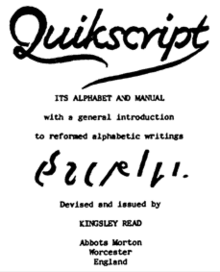Quikscript
Quikscript (also known as the Read Alphabet and Second Shaw) is an alphabet (and phonemic orthography) specifically designed for the English language. Quikscript replaces traditional English orthography, which uses the Latin alphabet, with completely new letters. It is phonemically regular, compact, and designed to be comfortably and quickly written. There are also Quikscript alphabets adapted for other languages, using the same letters for sounds which do not exist in English.
| Quikscript | |
|---|---|
| Type | Alphabet
|
| Creator | Kingsley Read |

Origins and history
George Bernard Shaw, the writer, critic and playwright, was a highly vocal critic of English spelling because it lacked a coherent system for representing the phonemes of English accurately. As a result, for years he wrote his literary works using Pitman shorthand. However, he found its limitations frustrating as well and realized that it was not a suitable replacement for the Latin alphabet, being difficult to use to produce printed material and impossible to type. A shorthand is, by definition, more specialized than an alphabet, which represents the standard written form of a language. Shaw desired and advocated a phonetic reworking of written English, and this called for a new alphabet.[1]
To that end, Shaw placed in his will provisions instructing his executor to organize a world-wide competition to design an improved English alphabet. A British designer, Ronald Kingsley Read, who had corresponded extensively with Shaw for several years regarding just such an alphabet, was selected along with three other finalists as the winners of the competition.[2] Read was chosen to design the final form of the alphabet. The "Shaw Alphabet", or "Shavian", as it is now generally known, was the result.
To provide field testing of the new alphabet, Read organized a lengthy public testing phase of Shavian by some 500 users from around the world who spoke different dialects of English. Once he had analyzed the results of those tests, Read decided to revise Shavian to incorporate a number of changes to improve the alphabet and make it both easier and faster to write. He called the revised alphabet "Quikscript". In 1966 he published the Quikscript manual which set out the alphabet's rationale, and briefly discussed different possible methods of alphabet reform. The heart of the manual provided comprehensive instructions regarding the use of the alphabet along with reading samples.
References
- Wilson, Richard Albert (1941). The Miraculous Birth of Language. London, England: JM Dent and Sons Ltd. pp. ix–xxxvii.
- Shaw, Bernard (1962). The Shaw Alphabet Edition of Androcles and the Lion. Harmondsworth, Middlesex, England: Penguin Books Ltd. pp. 9–11.